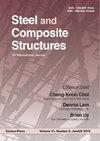Flexural behavior of prestressed hybrid wide flange beams with hollowed steel webs
IF 4
3区 工程技术
Q1 CONSTRUCTION & BUILDING TECHNOLOGY
引用次数: 0
Abstract
In this study, experiments were conducted to evaluate the flexural performance of prestressed hybrid wide flange (PHWF) beams with hollowed steel webs. A total of four PHWF beams were fabricated, where the width and spacing of the steel webs and the presence of cast-in-place (CIP) concrete were set as the main test parameters, and their flexural behavior and crack patterns, and the longitudinal strain distribution in a section with respect to the width and spacing of the steel webs were analyzed in detail. The experiment results showed that, as the ratio of the width to the spacing of the steel webs decreased, the flexural stiffness and strength of the PHWF beams without CIP concrete decreased. In addition, in the case of composite PHWF beam with CIP concrete, fully composite behavior between the precast concrete and the CIP concrete was achieved through the embedded steel member. Finite element analyses were performed for the PHWF beams considering the bond properties between the hollowed steel webs and concrete, and nonlinear flexural analyses were also conducted reflecting the pre-compressive strains introduced only into the bottom flange. From the comparison of the test and analysis results, it was confirmed that the analysis models proposed in this study well evaluated the flexural behavior of PHWF beams with and without CIP concrete.空心钢腹板预应力宽翼缘混合梁的受弯性能
本文对中空钢腹板预应力混合宽翼缘(PHWF)梁的抗弯性能进行了研究。以4根PHWF梁为主要试验参数,以钢腹板的宽度、间距和现浇混凝土的存在为主要试验参数,详细分析了其抗弯性能和裂缝形态,以及截面内纵向应变随钢腹板宽度和间距的分布。试验结果表明,随着钢腹板宽度与间距比的减小,未加CIP混凝土的PHWF梁的抗弯刚度和强度减小。此外,在CIP混凝土组合PHWF梁的情况下,预制混凝土与CIP混凝土之间的完全组合行为通过预埋钢构件实现。考虑空心钢腹板与混凝土之间的粘结特性,对PHWF梁进行了有限元分析,并进行了反映仅在底部翼缘引入预压应变的非线性抗弯分析。通过试验和分析结果的对比,证实了本文提出的分析模型能够较好地评价含和不含CIP混凝土的PHWF梁的受弯性能。
本文章由计算机程序翻译,如有差异,请以英文原文为准。
求助全文
约1分钟内获得全文
求助全文
来源期刊

Steel and Composite Structures
工程技术-材料科学:复合
CiteScore
8.50
自引率
19.60%
发文量
0
审稿时长
7.5 months
期刊介绍:
Steel & Composite Structures, An International Journal, provides and excellent publication channel which reports the up-to-date research developments in the steel structures and steel-concrete composite structures, and FRP plated structures from the international steel community. The research results reported in this journal address all the aspects of theoretical and experimental research, including Buckling/Stability, Fatigue/Fracture, Fire Performance, Connections, Frames/Bridges, Plates/Shells, Composite Structural Components, Hybrid Structures, Fabrication/Maintenance, Design Codes, Dynamics/Vibrations, Nonferrous Metal Structures, Non-metalic plates, Analytical Methods.
The Journal specially wishes to bridge the gap between the theoretical developments and practical applications for the benefits of both academic researchers and practicing engineers. In this light, contributions from the practicing engineers are especially welcome.
 求助内容:
求助内容: 应助结果提醒方式:
应助结果提醒方式:


